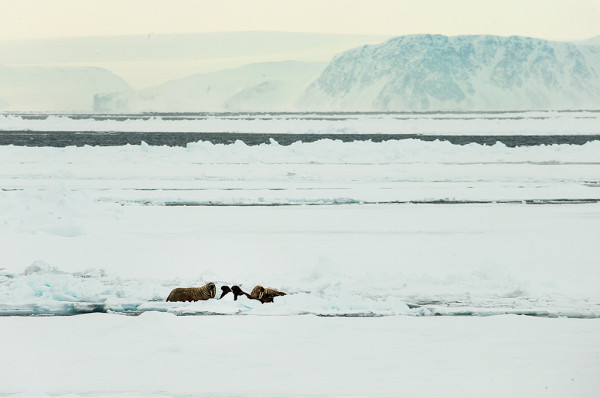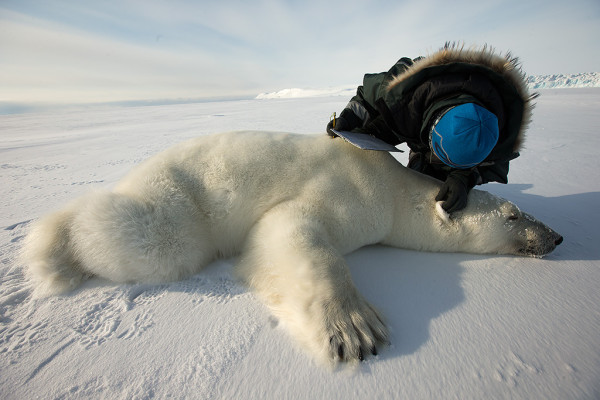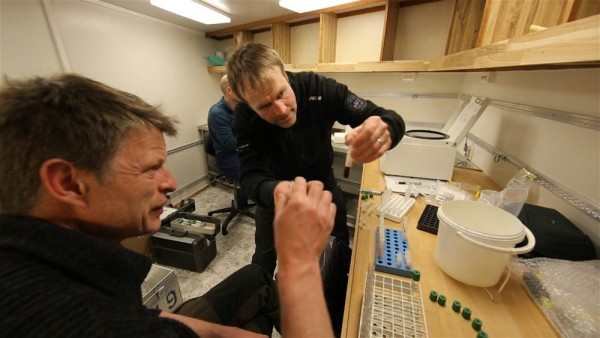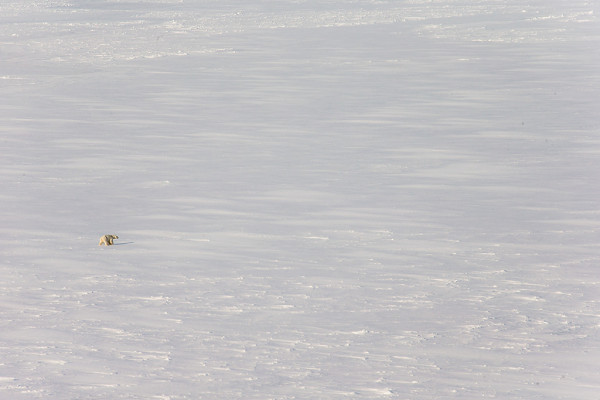There will be a security patch rolled out on all of our servers. The first maintenance will be done on May 12th 2014 at 09:30 am GMT on the wwf-web-2 server. Continue reading
Monthly Archives: April 2014
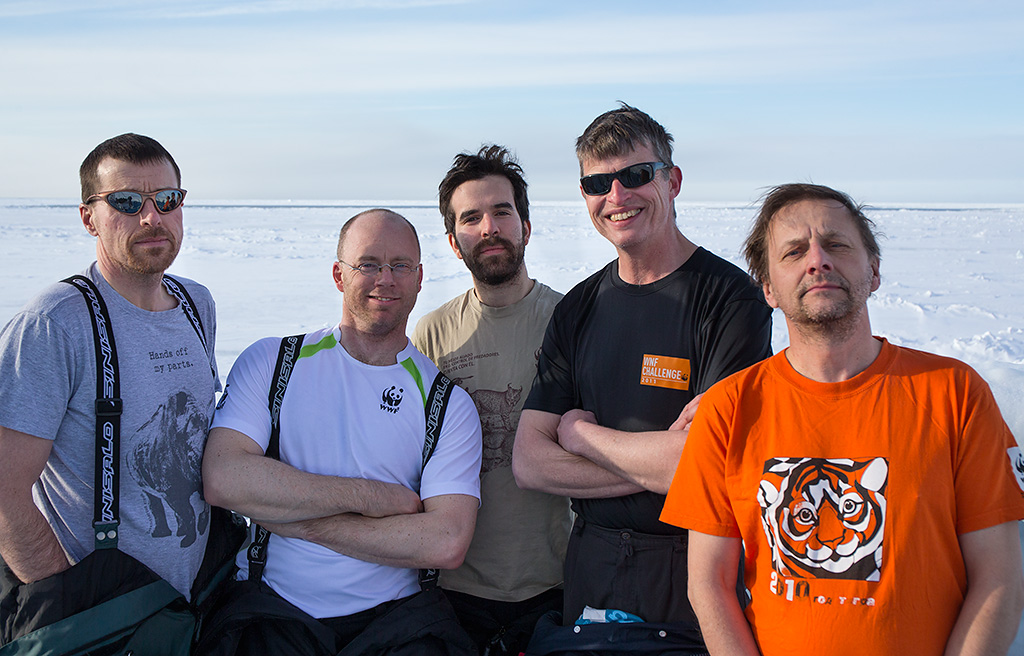
Back to Longyearbyen
From April 11 to 21, 2014, join a Norwegian Polar Institute and WWF-Canon scientific expedition to collect critical data about Europe’s most westerly polar bear population. The population on and around the Norwegian Arctic archipelago of Svalbard is facing a future without summer sea ice. See all posts from the expedition here.
April 21, 2014

The Svalbard team on a “warm” spring day in the Arctic. Left to right, Geoff York, Reinout Bolweg, Guillermo Prudencio, Gert Polet, Tom Arnbom. © Brutus Ostling / WWF-Canon
Today, we will wrap up the ship based portion of NPI’s spring polar bear survey effort. The seas have calmed into gently rolling swells by breakfast and mostly clear skies allow views of the southwestern shores of Spitsbergen and its namesake pointed mountains rising abruptly from the dark ocean. Northern fulmars continue to be our constant companions, soaring around the ship and her rigging. The captain estimates a 3 PM arrival into Longyearbyen where the ship and crew will refuel, restock, and prepare for their next research cruise scheduled for departure tomorrow night.
Jon, Magnus, and the helicopter crew will finish out the final two weeks of survey work flying from Longyearbyen, basing for several days at a research cabin on Barentsøya, and using fuel caches strategically placed around the island to extend their range. Weather limited our last few days of flying and survey work, especially in the northeast, so they still have a number of collars to deploy. I’ll also be interested to hear the final count of family groups observed, both mums with cubs from this year and yearling cubs from last year as an important indicator of reproductive success.
Monitoring wildlife takes time, financial investment, and effort to develop meaningful data sets over periods long enough to detect trends. Monitoring polar bears is further complicated by their remote and broad distribution across historically frozen seas in a part of the world that is largely inaccessible for many months of the year. The cost of setting up, running, and maintaining field camps is much higher and more logistically complicated than similar work elsewhere. The windows of time that polar bears are more easily accessible are also fairly short and much of our traditional work (observations, aerial survey, and aerial based capture) is highly weather dependent. Even with the best support and planning, there are few guarantees this far north.
Data gathered on this trip and in the coming year via satellite collars, geo-location ear tags, and TDR tags (Temperature and Depth Recorder) will add considerably to our collective understanding of polar bears in the Barents Sea, their use of habitat, and their response to change. To turn this data into information however requires long term monitoring, not just a single season. Even when conditions in the Arctic were more stable, there were always good and bad years for polar bears. The challenge is to separate the short term variation, what we would consider natural background fluctuations, from significant long term trends. Even more challenging but critical is to combine this with the best available projections on climate and sea ice to try and predict future responses of polar bears to expected loss of sea ice habitat.
The coolest office
From April 11 to 21, 2014, join a Norwegian Polar Institute and WWF-Canon scientific expedition to collect critical data about Europe’s most westerly polar bear population. The population on and around the Norwegian Arctic archipelago of Svalbard is facing a future without summer sea ice. See all posts from the expedition here.
Being out in the field, you sometimes encounter challenges, like having an open space office in the High Arctic. We are here to study polar bears at the northeastern tip of Svalbard which is situated above 80th latitude North. That is far above the Arctic Circle.
In addition to the research, we send out short videos and news stories from the field. Where we are right now, there is no mobile system or internet connection so we rely totally on satellite communication. By using a satellite telephone connected to a box ,which is a wireless router, it is possible via the laptop to get our messages out. However, the batteries run flat in short time due to the cold. Therefore, I often have extra batteries in my pockets closest to the body to keep them warm, to last a little bit longer.
I would call it a room with a view, but the temperature can drop to minus 15 degrees Celsius and we have to be outside to get the best possible chance to transmit to the passing satellites . We, as the researchers, have to be very careful whilst working in this Arctic cold environment. It is easy to freeze your hands and fingers when you work without gloves and mittens. You do what you should do and then directly put on the gloves to keep you warm.
From the most northern WWF field office – At the edge of what is possible!
Seal spotting
From April 11 to 21, 2014, join a Norwegian Polar Institute and WWF-Canon scientific expedition to collect critical data about Europe’s most westerly polar bear population. The population on and around the Norwegian Arctic archipelago of Svalbard is facing a future without summer sea ice. See all posts from the expedition here.
I was sitting by the computer transferring some pictures, when something caught my eye, far away from the boat. The ice did not look exactly the same as it did a few minutes ago. Through my binoculars I saw a polar bear, probaly a male, slowly but steady moving towards us. It did not take long before the rest onboard were observing the bear, more than 1,000 metres away.
The bear sniffed along a crack in the sea ice, searching for seals to catch. Then suddenly I realized it had something in it mouth — a ring seal. The bear was quickly moving the ~60 kg seal away from its breathing hole. Less than one hour later, almost nothing was left for the twenty five glacous gulls which had patiently been waiting for the bear to leave. Just skin and skeleton. Here in front of us, an Arctic drama.
The most common prey for the polar bear is the ringed seal. Other ice-living seals are harp, hooded, banded, spotted and bearded seals. They are all dependant on the sea ice to reproduce and rest. The hooded seal breeds in loose ice and their pups are only nursed for four days – yet their weight increases by three to four times. At the other end is the largest seal species, the walrus, which nurses its pups over more than two years. Arctic is seal heaven for animal lovers.
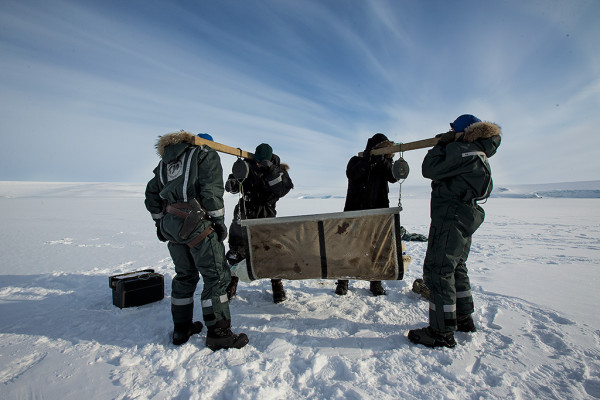
In photos: Polar bear research on Svalbard
From April 11 to 21, 2014, join a Norwegian Polar Institute and WWF-Canon scientific expedition to collect critical data about Europe’s most westerly polar bear population. The population on and around the Norwegian Arctic archipelago of Svalbard is facing a future without summer sea ice. See all posts from the expedition here.
[metaslider id=”5811″]

Ringed seals feel the heat
From April 11 to 21, 2014, join a Norwegian Polar Institute and WWF-Canon scientific expedition to collect critical data about Europe’s most westerly polar bear population. The population on and around the Norwegian Arctic archipelago of Svalbard is facing a future without summer sea ice. See all posts from the expedition here.
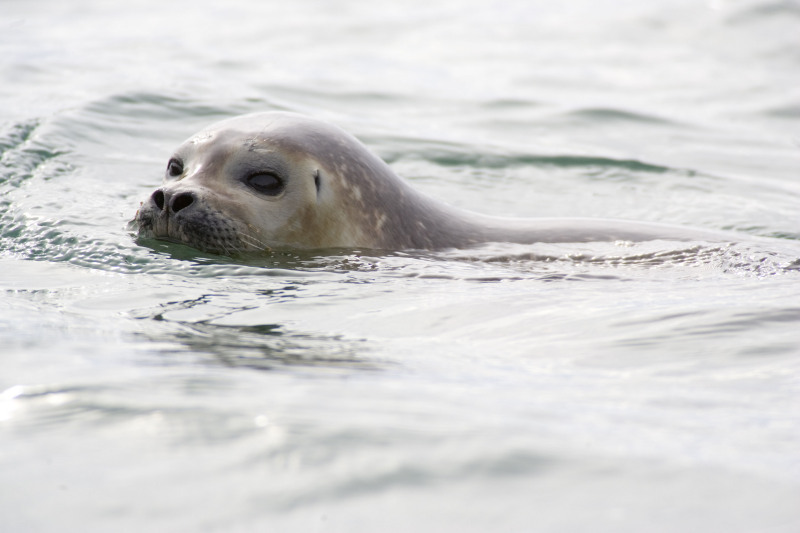
Head of ringed seal above the water. Blomsterhalvøya, Spitsbergen (Svalbard) arctic archipelago, Norway.
© WWF-Canon / Sindre Kinnerød
April 16, 2014
For the first time this trip, I was wide awake late in the evening. The ship was sailing back above 80 degrees north latitude and heading into the fringe of this winters pack ice- things could get interesting. Large ice bergs calved from glaciers on the north side of Nordaustlandet Island in previous years stood out on the horizon and the ships radar, surrounded by young sea ice only frozen in the last few weeks. Ice formation was quite late in the Barents Sea this winter and remained well below average in final extent. All of the areas we’d been sailing through should have been solid ice and were just a few years back. This year, Svalbard was ice free on all sides until the very end of the winter.
The low angle ‘evening’ light is absolutely perfect to illuminate the contrasting dark open water and floes of drift and young consolidated ice dotted occasionally with deep blue blocks of ancient glacial ice. While the sun never truly sets, it does dip down just to the horizon, teasing us with a nightfall that will not return here for many months. The Lance glides into this surreal sea and ice scape with little effort- this young ice, while starting to look more like solid first year ice, is still relatively soft and thin. Good enough for seals and walrus to haul out on and for polar bears to walk on, but not good breeding habitat for ringed seals as the ice formed too late, is very flat (no relief or pressure ridges to collect snow), and there is only a skim of light snow.
While we often hear about the plight of the polar bear in popular news and media, we rarely hear about the effects a rapidly warming Arctic is having on their primary prey, the ringed seal. Due to both the rapidly changing conditions and to long term research and monitoring of seals in the area by NPI, Svalbard may be the best place in the world to begin understanding the potential impacts of climate change for this important species. Along with being the primary food for polar bears across the Arctic, it is also one of the top three foods consumed by coastal dwelling Arctic peoples and is a nutritional powerhouse without easy replacement.
Over breakfast discussions with our colleagues at NPI we learn that research here on ringed seals is starting to show disturbing trends. Lack of sea ice in many places coupled with conditions like those surrounding us here (thin flat ice with inadequate snow) are leading to reproductive failure of ringed seals in some years and locations. Newborn pups rely on well-placed lairs (snow caves on top of the ice, adjacent to pressure ridges or ice blocks, and with a breathing hole for access to the sea) to protect them from hungry predators like polar bears, Arctic Fox, and even gulls. Without that protection, they are easy prey. While that is good news for some bears in the short term, it will lead to long term difficulties as ringed seal populations ultimately decline in abundance and potentially shift in distribution. I also wonder about potential changes in what is called synchrony- polar bears have evolved to take advantage of ringed seal pupping during a specific time window each spring. Den emergence and seasonal migrations are tied to this window of food abundance. What will happen if that window closes or shifts significantly in time?
The capture team will start the day looking at the Seven Islands in the Nordenskioldbukta before turning their efforts to the main island. We’ll continue to push East with the Lance- as far as the sea ice will allow us to go in this vessel. The weather forecast is showing high winds, snow, and poor visibility for all of Svalbard tomorrow, so the helicopter crew is anxious to make the most of the time they have today. We spy a few more ivory gulls (when I say we, I mean our resident expert from Sweden Tom Arnbom- a serious birder!) as we push further into the ice, the odd bearded seal, and solitary walrus are becoming more common. We’ve still seen very few ringed seals, but hope that will change as we progress today.

Breaking out of the ice
From April 11 to 21, 2014, join a Norwegian Polar Institute and WWF-Canon scientific expedition to collect critical data about Europe’s most westerly polar bear population. The population on and around the Norwegian Arctic archipelago of Svalbard is facing a future without summer sea ice. See all posts from the expedition here.
After a successful morning of capture work yesterday, two adult males and one adult female, we decide to head back west. The Lance had pushed into the first year ice pack about 100 meters in lieu of anchoring. Now she proceeds to break free from the ice that has refrozen again around us. A combination of forward and reverse motion with specially designed air jets along the side help break up the young ice just enough for us to turn the ship and head back out into the open sea.
The ship will motor overnight up Hinlopenstretet and then down Wijdefjorden. Our goal is to get close enough to Longyearbyen that the research team from NPI can fly directly across the mountains and retrieve a new shipment of satellite collars that was delayed from the manufacturer. On their return they will look for a female that was collared last year and has a maternal den near the head of the fjord.
As we sail north, the weather turns south quickly. Sun, blue skies, and fairly flat seas are replaced by swirling clouds, snow blowing horizontally, and churning seas that soon start to break over the ship’s bow. With a tall, 3 story structure, the Lance leans from the wind like a vessel under sail, pitching and rolling as she slowly makes her way into the squall. We turn south into Wijdefjorden just before bed time and find much smoother sailing overnight.
The view in the morning has changed for the better and the ship sits quietly next to an area of new ice. We are surrounded by steep, snow covered mountains in a fairly narrow fjord- the longest on Svalbard. A few early risers were rewarded with a glimpse of a polar bear walking along the far eastern shore- the first we have seen from the ship- fantastic!
Once the capture crew heads off for the day, we will spend some time processing a sample of snow to test a potentially useful new genetic technique- obtaining viable DNA from polar bear footprints. This is a pilot effort we are trying in Norway and in the US to determine the feasibility and accuracy of the proposed method. It’s a collaboration with a French genetics lab that has shown this is possible with other species. If successful in the testing phase, this technique could be used in the more remote parts of the Arctic where we lack basic information or the capacity for monitoring. It would also be an excellent tool for community based efforts as sample collection and preservation is very straightforward. I would love to try a similar technique for collection of genetic material from polar bear dens in the coming years.
The first bears
From April 11 to 21, 2014, join a Norwegian Polar Institute and WWF-Canon scientific expedition to collect critical data about Europe’s most westerly polar bear population. The population on and around the Norwegian Arctic archipelago of Svalbard is facing a future without summer sea ice. See all posts from the expedition here.

Not all aspects of polar bear research are high-tech. Here, the researchers weigh a bear. © Brutus Ostling / WWF-Canon
The capture mission last night was successful- one recaptured female who was fitted with a fresh satellite collar and one large male. The crew from NPI is very efficient with their sample processing and equipment cleaning routine: spinning whole blood samples, separating serum and packed red cells, while cleaning and repacking equipment for the next day. It is a real treat and great learning opportunity to watch colleagues in the field, comparing methods and brainstorming new ideas. I’m certain that the makers and sellers of fishing tackle boxes never imagined how wildlife biologists around the world would use their products one day!
Overnight, the ship moved further north around the northern tip of Spitsbergen before turning southeast down Hinlopenstretet to the Island and strict nature reserve of Nordaustlandet- the true kingdom of the polar bear and walrus. Once again, as if scheduled, we are all awakened by the sudden rumble and swish of the ship breaking ice as she finds a spot to park in Wahlenbergfjorden at 5 AM. This is much thicker ice than before and we look out to a completely fast frozen seascape of ice that is 2-3 feet thick and dotted with glacial bergs much thicker and looking like deep blue jewels strewn across the fjord. The land here is much lower and fairly flat on top, though it still rises sharply from the shore.
After the capture crew sets off, those of us on the boat prepare to go for a short walk on the sea ice near the ship as the crew works to anchor us in for a couple of days. For two of our team, it is their first trip to the Arctic and their first time walking on frozen ocean. As luck would have it, within 50 meters of the ship we encounter fresh polar bear tracks! As the assigned bear guard, I scout the vicinity to make sure the track maker is not still close by before waving the team over for a closer look. Standing on a small blue ice berg in the otherwise frozen fjord, we have a commanding view of the fjord, some glaciers, and the surrounding landscape. Absolutely beautiful, even when draped all in white snow and ice.
A polar bear in sight
From April 11 to 21, 2014, join a Norwegian Polar Institute and WWF-Canon scientific expedition to collect critical data about Europe’s most westerly polar bear population. The population on and around the Norwegian Arctic archipelago of Svalbard is facing a future without summer sea ice. See all posts from the expedition here.
At distance, a single polar bear is in sight. It is like a light dot in a enormous white landscape. We are in Wijdefiorden which is a fiord which cuts right through Svalbard. Most of the fiord is open water but at the southern end, there is a layer of new ice. It is here we observe the polar bear. Polar bears are hard to detect in the snowy and icy landscape, which is an advantage if you are a predator and want to catch seals. Their claws are incredibly strong and sharp- perfectly designed for catching and holding seals. We humans, use ice picks to climb glaciers, polar bears use four, each leg is equipped with a paw with five sharpened claws. The paws are also very broad, and this helps the bear spread out more of its weight to avoid braking through thin sea ice. We hope this polar bear will get a bit closer. To our surprise, we found polar bear tracks rounding the bow. This is the second time we have foot prints of this big white predator close to the boat, without seeing it.
Today, the sun is beaming on the snowy mountain slopes. However, yesterday evening the contrast could not have been greater. As the R/V Lance travelled from Wahlenbergfjorden up Hinlopenstretet and into Wijdefiorden we hit some bad weather. The waves where crashing over the ship and the sea water froze immediately to ice when it hit me while I stood on deck. This was a lifetime experience and I could immediately understand the danger of a ship being ‘iced’ by the Arctic sea. Tons of kilograms ice can freeze solid to ship decking and the crew gets rid of it by using rubber sledge hammers and manual labor.
A relevant question might be what was I doing outside on deck in an Arctic storm? I had been asked to make a statement, in the worse weather condition as possible, to explain why we have to join forces from different countries to save the Arctic. We have to put aside all the ‘squabble’ such as between Sweden and Finland where there is always some hard feelings when our national teams meet in ice hockey or cross-country skiing.
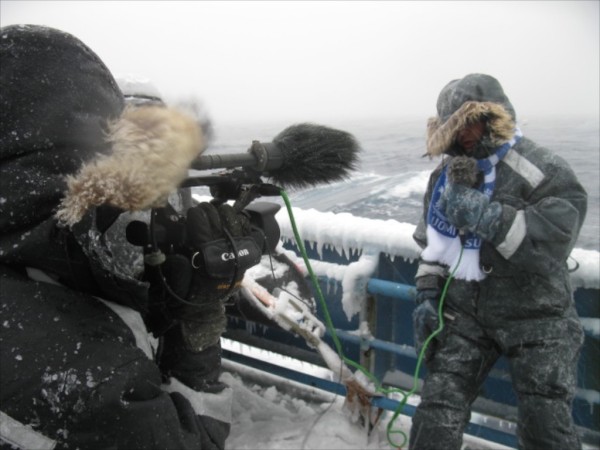
Tom puts aside any rivalry between Finland and Sweden in the spirit of Arctic cooperation. © Guillermo Prudencio / WWF-Canon
It is amazing to be up here, and we will soon have more to say about the polar bear we spotted.
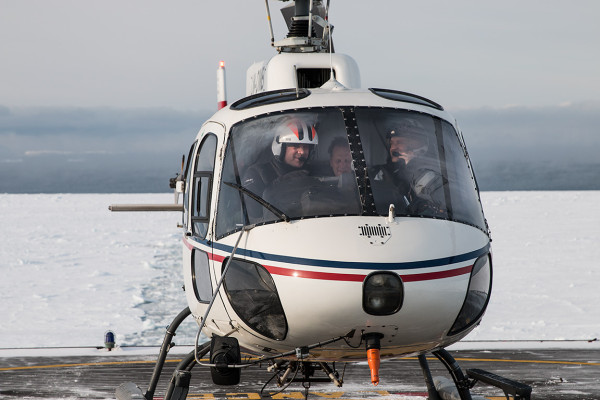
Headed out in search of bears

NPI researchers and Brutus Ostling, Canon ambassador, prepare to take off for polar bear survey. © Tom Arnbom / WWF-Canon
From April 11 to 21, 2014, join a Norwegian Polar Institute and WWF-Canon scientific expedition to collect critical data about Europe’s most westerly polar bear population. The population on and around the Norwegian Arctic archipelago of Svalbard is facing a future without summer sea ice. See all posts from the expedition here.
Pitch and roll, pitch and roll as we settled into our bunks last night. Just enough seas to make things interesting. A thud on the hull at 5 AM followed by a familiar hiss and occasional shudder stirs me to wake. The boat motion is now perfectly still and it takes a minute to discern if we are still moving. Outside the port hole, the churning seas are now solid white- we are in the ice. While not a heavy ice breaker, the Lance is capable of cruising through shore fast and most first year ice.
When I come up to the bridge, we are almost at 80 degrees latitude approaching the north western tip of Spitsbergen and passing by the old Dutch whaling station of Smeerenburg. Those on our team that are new to the Arctic are already on deck with cameras and binoculars taking stock of this fascinating new sea and icescape. Our videographer Rhineout is all smiles as he jumps from spot to spot looking for unique viewpoints, oblivious to the -17 C temperatures. The bow of the ship is also a frozen ice-scape as spray from our evening cruise in rough seas is frozen on the rigging and anything metallic on deck.
We’ll spend much of the day maneuvering into Woodfjiorden where NPI has a collared female polar bear they hope to recapture. The weather shifts from localized dense fog patches to clear blue skies. Sea bird sightings are common and include guillemots, little auks, fulmars, and even two ivory gulls. Walrus are seen early-morning and we pass closely by five bearded seals mid-day before arriving in the fjord and launching the first helicopter survey.
Polar bear research on the cutting edge
As a polar bear field biologist, this is a great opportunity for me to talk with my colleagues at NPI, Jon Aars and Magnus Anderson, to compare notes and share experiences. Unfortunately, due to schedules and distance, this is altogether too rare amongst our colleagues globally. Each region we work in is unique in some aspects of both general ecology and bear behavior. In Svalbard polar bears share the marine world with the usual suspects- walrus, ringed and bearded seals, along with beluga and the rare bowhead whale, but they also have species here that are new to me- harp and hooded seals, narwhal and fin whale to name a few. NPI also have their own uniquely laid out capture kits and systems of working on bears to collect samples once sedated. This year they are testing an exciting new dart delivery system that, if successful, will be much less invasive than current equipment.
The team at NPI is also pioneering work in the use of geo-location ear tags that store a surprising amount of data on a chip set the size of a small coin- including temperature. These smart tags can provide coarse location data, but the temperature and light information may be able to identify denning events. New technology, improved capture tools, and advances in the drugs available for wildlife capture will continue to advance our understanding of this sentinel species and how it is responding to rapid changes in the Arctic environment.
Changes we are already seeing in real time as both the fjords around Longyearbyen and the one we sit in now should be covered in first year, shore fast ice- but both are completely ice free. Jon has worked here now for 11 years and has never seen so little ice. This not only complicates his research (he cannot safely land on the young ice still available in some areas), it also complicates life for the bears, especially females emerging from maternal dens and looking to hunt on the ice for much needed calories.
Our colleagues also remind us that it’s not just the ice that is missing, parts of Svalbard are receiving less snowfall, and this is starting to impact the primary food of the polar bear- ringed seals. Researchers in eastern Spitsbergen are estimating near complete failure of ringed seal recruitment (survival of newborns to adulthood) in some areas and years due to lack of snow cover for their normally protective snow lairs. This may be an indicator of changes to come as other parts of the Arctic warm, and it is not good news for polar bears.


